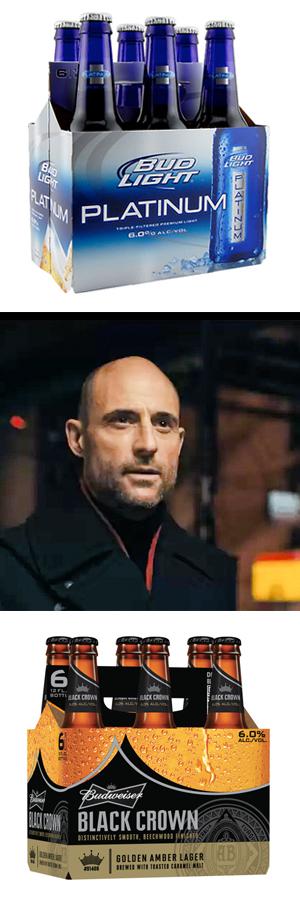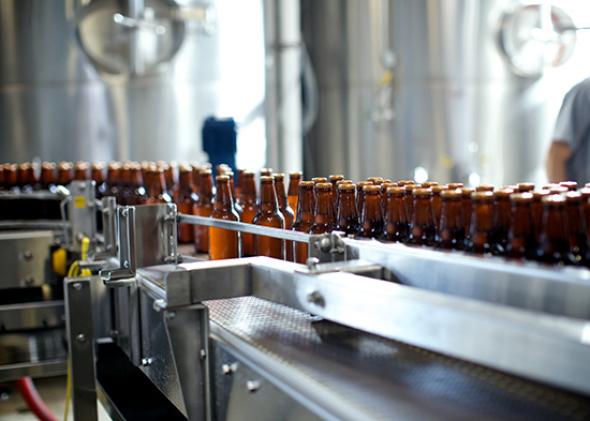America’s industrial breweries have seen better days. Sales of domestic beers have plateaued and even started to show signs of declining. Worse for Big Beer, it seems the new generation of drinkers prefers bottom-shelf value beers like Pabst Blue Ribbon over ostensibly “premium” brews like Budweiser. Using brand alone to differentiate nearly identical light lagers isn’t working anymore.
Meanwhile, craft beer—a category famous for its obsession with hops, bearded hobbyists, and esoteric style varieties—is eating into industry giants’ market share. Craft breweries are growing quickly and now produce nearly 8 percent of the beer consumed in the U.S. While the definition of “craft beer” remains nebulous (and continually gets redefined to include ever-larger operations), it effectively refers to breweries that focus on styles other than light lagers and emphasize flavor and ingredients rather than price or brand marketing. It’s not hard to see how this has succeeded: In an industry built on nearly identical products, the merest hint of innovation has gone a long way.

Courtesy of the manufacturers
What’s a major beer producer to do in the face of strong market headwinds? In recent years, Anheuser-Busch and MillerCoors have launched, at extremely high cost, a variety of new brands and labels, including Bud Light Platinum, the ostensibly bourbon-flavored Miller Fortune, and Budweiser’s Black Crown line. But these new spins on the same old lager aren’t converting twentysomethings who would rather drink PBR or Lagunitas IPA (or wine or spirits, for that matter). According to AB InBev’s most recent quarterly report, Black Crown struggled so much that a companywide 0.4 percent market share decline was “due primarily to the cycling of Budweiser Black Crown launch volumes.” Bud Light Platinum similarly burned out rapidly after a strong launch. It’s too early to know for sure what will happen with “undistilled” and “spirited” Miller Fortune, but it is worth noting that MillerCoors fired its primary ad agency, Saatchi & Saatchi, within months of launching an ad campaign in which a mysterious British man encourages young professionals to drink Fortune and stay out late. If you need to persuade young people to drink beer and stay out late, something is going very wrong.
Luckily, there’s a big opening for Anheuser-Busch and MillerCoors to push back against the inroads of craft beer as well as the more existential threats posed by wine and spirits. That’s because there are a few styles of craft beer that are beloved by connoisseurs but have specific production issues that make it difficult or impossible for craft brewers to produce enough of them to meet the potential demand. Even better, these styles don’t just appeal to beer snobs—they have the flavor potential to appeal to casual beer drinkers as well as wine and cocktail lovers. If any executives at Budweiser and Miller are smart enough to see the opportunity, tart saisons, bourbon-barrel strong ales, and tropical New Zealand pale ales are free for the taking.
Belgian beer has already provided the beer industry with one of its few legitimate breakout hits of the last 20 years: Blue Moon from Coors, inspired by the Belgian witbier style. The tart saison is a more obscure style of Belgian beer, and it could become a go-to lower-alcohol beverage for wine and champagne drinkers looking for a lighter quaff on warm summer days. A classic tart saison (or its sister style, the grisette) can be produced in about the same amount of time as a lager and deliver a crisp mouthfeel with a lightly sour and white wine–like flavor. It’s refreshing and complex, yet can deliver as little as 4 percent alcohol by volume, roughly equal to a Bud Light.

Courtesy of Allagash Brewing/Flickr Creative Commons
So what’s stopping craft breweries from putting out tart saisons by the truckfull? The style incorporates ingredients that make most small-scale brewers nervous: wine yeast; souring lactic-acid producing bacteria (many of the same kinds used in yogurt); and brettanomyces, a rogue yeast strain that will eat every available sugar it can find, give off funky flavors, and occasionally cause bottles to explode if it’s handled incorrectly. Because of the flavor problems these wild microbes can cause in conventional beers, few American craft brewers make tart saisons, and those that do, like Hill Farmstead in Vermont, tend to release them only at the brewery in limited supply at high price points.
For Anheuser-Busch or MillerCoors, however, it would be relatively trivial to convert an entire facility to making nothing but saisons and ensure great supply at low prices. In 2011, Anheuser-Busch acquired Goose Island in Chicago, which makes a fine saison called Sofie, but prices have not fallen since the acquisition, in part because they’re still making it at the tiny Goose Island production facility. Move production of Sofie (and that of its delicious fruit-laden siblings Halia, Lolita, and Madame Rose) to an industrial brewery to drop the price, and Anheuser-Busch is practically guaranteed to earn more respect from saison snobs and begin to win the interest of wine drinkers.*
Industrial breweries also have an opportunity to appeal to whiskey aficionados—not with that vile Miller Fortune, which tastes nothing like bourbon, but with bourbon barrel-aged ales. In the early 1990s, craft breweries began aging strong beers in wooden barrels that had already been used to age bourbon in order to impart a notable whiskey flavor and aroma. Examples include Kentucky Bourbon Barrel Ale and Bourbon County Brand Stout, a product line from Goose Island that melds a strong, dark imperial stout’s coffee and chocolate flavors with a premium bourbon taste to create the most decadent dessert beer around.

Photo by Steve Jennings/Getty Images for Goose Island
It’s become common for craft brewers to produce barrel-aged beers on special occasions like anniversaries or the holidays. It’s not common, however, for such small brewers to try to make barrel-aged strong ales part of their everyday lineup. That’s because it typically takes almost a year of barrel-aging to impart the desired flavor and smooth out the beer’s astringency. Then there’s the fact that extended wood aging carries a risk of contamination and off-flavors from undesired wild yeast and bacteria that might secretly live in the wood. Plus, small brewers tend to lack the storage space to hold on to barrels for years, and quality barrels are expensive and difficult to source quickly. It’s one headache after another.
Major brewers, by contrast, already have the connections with distillers they need to get first crack at high-quality barrels, thanks to their ownership of alcohol distributors. Big brewers also have the space to produce bourbon-barrel strong ales at lower prices than anyone else. Additionally, they have access to the sanitation equipment required to defend barrels against wild yeast. Year-round bourbon barrel beers could be a hit with spirits drinkers—and they would be a way for beer-makers to profit from the rising interest and demand for top-tier bourbon that has fueled the recent spirits boom.
And then there’s the beer that will appeal to both hardcore beer mavens and craft beer skeptics: the New Zealand pale ale. Pale ales—especially India pale ales—are typically hoppy, which often translates to a strong bitterness that is off-putting to all but the most dedicated craft bros. But hops are actually capable of imparting a variety of flavors, from spice to grassiness to pine and citrus. New Zealand and Australian hops, for whatever reason (likely the soil and climate in which they are grown, but it’s a source of serious debate), have a tendency to impart remarkable flavors of tropical fruit, from key lime to mango and pineapple. A select few craft brewers (notably Alpine near San Diego and Schlafly in St. Louis) have begun to specialize in NZPAs. These beers are delicious when fresh, and taste nothing like the classic and niche flavor profile of an IPA.
Unfortunately, NZPAs tend to be both hard to find and significantly more expensive than standard IPAs. Worse, since they depend on hopping techniques that impart aroma and flavor through volatile essential oils, they are highly susceptible to destructive oxidation. Drink it more than 30 days after bottling, and the special tropical aroma and flavors disappear in favor of stale, cardboard-like malt. All this, and the needed hops are in perennial short supply—New Zealand is a really tiny country.
But an increase in demand could lead to an increase in growth of these hop strains, bringing down prices and ensuring adequate volume. Launching a nationally available NZPA that’s guaranteed to taste fresh would require local production in every region of the country, a great supply chain that limits exposure to heat, and packaging innovations that can fight flavor degradation—exactly the advantages the big brewers have over the small guys. It was Budweiser, after all, that created the “born-on date” for its beer to educate consumers about the quality difference between fresh beer and the dusty stuff that’s been sitting on the shelf since the Carter administration.
Craft beer connoisseurs will always prefer independent breweries to big corporations—but a big corporation is the only kind of company that can make these styles widely and consistently available. If the major producers were to dedicate themselves to capturing the opportunities of bourbon-barrel strong ales, tart saisons, and NZPAs—figuring out how to scale and speed production and increase distribution and awareness—they could find themselves beloved instead of reviled by beer snobs. At the same time, since these are more accessible styles than the überhoppy ales prized by craft beer zealots, big breweries stand to win over new beer drinkers. An Anheuser-Busch tart saison or a MillerCoors NZPA would be a win for everyone—except, perhaps, for the two or three people who actually like Bud Light Platinum.
Correction, July 9, 2014: This article originally referred to Goose Island’s Lolita and Madame Rose as saisons. Although they share a sour flavor profile, Lolita is a wine-barrel aged Belgian pale ale and Madame Rose is a Flanders-style Old Bruin.
